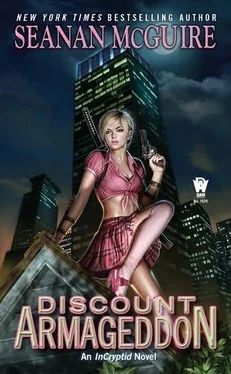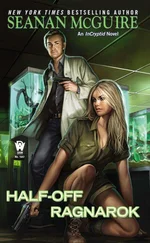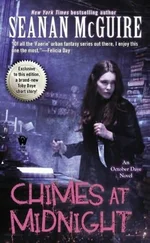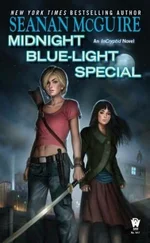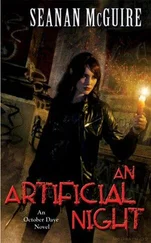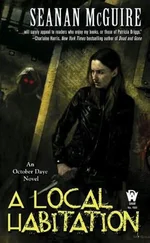Some stuff could be managed at home. I knew how to handle a firearm, lay a snare, and dress a wound by the time I was five. I remember getting to elementary school and being amazed to discover that most children played sanitized versions of the games I knew; their idea of a good time seemed like a cat that had been declawed, all hiss and no interesting danger. What was the point of hide-and-seek if you weren’t allowed to dig pit traps or attack your opponents from behind? That was the first time I realized how different our home life was from everyone else’s. Everyone else wasn’t being taught to fight a war.
Our parents planned our education as carefully as they would have planned an invasion of France. To keep us interested, they let us decide how to specialize. My brother went for guns, more guns, bigger guns, and, also, guns. Antimony focused on traps, poisons, and keeping the fight as far from herself as possible. I learned to shoot, I learned to fight, and when the time came to pick what I wanted to devote myself to studying, I chose the thing I was most passionate about: ballroom dance.
I argued my case like a master. A surprisingly large number of fighting styles have a lot in common with dancing. Speed, flexibility, and the ability to kick higher than your own head are all things that come in handy when you’re fighting for your life. Most professional dancers live to dance, and that’s the sort of passion people in our position need to bring to their individual disciplines if they want to survive long enough to get really good at them.
We weren’t allowed to compete in any sport or activity the Covenant might be monitoring. Antimony got her black belt in karate, but was never allowed to go to any national events. Alex had to drop soccer when he got to college, on the off chance that he’d somehow make the news. And I, with my weird obsession with the Latin forms of ballroom dancing? With my urge to salsa and rumba and cha-cha my nights away? I was allowed to put on a red wig, get a false ID from our crazy cousin Artie, and audition for Dance or Die . And when the producers said I had a slot in the top twenty, I was allowed to compete.
The format is familiar to everyone in the country who owns a TV not permanently turned to either PBS or porn: ten girls, ten guys, one massive cash prize. Every week two dancers get sent home, until the top four try to dance their way to victory without dancing themselves into heart failure. (My season was better than some; we only lost one contestant to health issues, and he was an idiot who stopped sleeping and gave himself pneumonia.) I didn’t win. I didn’t expect to. But I came in second.
Two of the show’s regular judges were cryptids, and so were three of the other competitors. My experiences with them, and the connections I managed to make within the Los Angeles cryptid community, were the final push I needed to get the consent for my studies in New York City. Of course Dave wanted me to dance for him. He could make some serious dough by putting my stage name on his roster of naked talent.
Competitive ballroom dance may have a reputation for skimpy dresses and sky-high heels, but at least sequins aren’t see-through. I’d been saying thanks but no thanks to Dave for months. I was there to work tables and make contacts, not sacrifice what little dignity I had left.
Of course, give me a few more months trying to pay for groceries on a cocktail waitress’ salary and tips, and that could change. All he really had to do was wait me out.
* * *
Carol was still in the dressing room with her wig in her hands when I returned. Her snakes hissed merrily, glad to be released from their confinement, as she stared morosely into the mirror.
“Hey, Carol,” I said, heading for my locker. “What’s wrong?”
“I can’t go back out there until I get my wig on, and I really need the tips,” she said, glancing back toward me. “I had to feed them last week.”
“Ouch.” I winced. Gorgon hair requires live feeding, and Carol had at least thirty individual snakes topping her head. They would have each demanded a pinky mouse of their own, possibly two or three in the case of the larger serpents. “Still no luck breeding your own?”
“I can’t wear my contacts all the time. I keep looking at them by mistake.”
“I can see where that would be a problem.” Untying my apron, I added, “I can call my mom if you want. She might have something you can use to sedate them without hurting them.”
“Could you?” Carol whirled to face me, clutching her wig to her breast and looking at me like I was the answer to all her prayers. “I didn’t want to ask, but…”
“It’s no big. Really.”
Here’s a fun fact: there are over nine hundred races of cryptids on the planet, and maybe eighty of those look roughly human, ranging from the Sasquatches and gorgons to dragon princesses and cuckoos. Here’s another fun fact: most of those races have only started coming into intentional contact with humans during the last hundred and fifty years, as our expansionistic tendencies brought us to them. Many have little to no idea of their own biology, and still practice a form of folk medicine that the human race abandoned centuries ago.
Which is where my mother comes in. Evelyn Price, formerly Evelyn Baker, is the closest thing to a cryptid physician most of them will ever meet. She’ll even make house calls if you can find her a teleport, and her rates are more than reasonable.
Carol burbled a series of thanks before she went back to trying to cram her snakes into the wig. I took her distraction as the opportunity it was and dug my weapons out of the locker. I always feel better with a knife, and better yet with a firearm or two. I was only carrying a simple underarm holster, but that was fine; those are the easiest to hide. Pulling on a windbreaker, I shoved my street clothes into my emergency backpack and shrugged it on before scooting for the hall. I didn’t see the point in changing. After a mice-related kitchen incident, a boob-grab by an asshole, and a private talk with Dave, I was more than ready to get out on the rooftops. Running in a skirt may be a little bit indecent, but I don’t mind doing it as long as I’m not going to need to talk to any humans.
The night had matured while I was inside, ambient noise going from the mindless cheer of early evening to something deeper and more classical. A siren wailed in the distance; horns honked on the street below; a baby’s crying drifted out of an apartment window. It only needed a saxophone or maybe some feel-good easy listening music to make the stereotype complete.
I took several deep breaths of the night air, letting the tension slip out of my shoulders before backing up, putting my back against the rooftop door, and breaking into a run. If I couldn’t take my aggressions out on Dave’s customers, I’d do a quick circuit, head home, call Sarah, and go clubbing.
It’s always the best plans that fall through. I think the universe has some sort of law.
* * *
Ever wonder why pigeons need to breed so fast when they’re living in an environment that’s entirely man-made, offering all the comforts and amenities a brainless ball of feathers and pestilence could desire? If you just look at the immediately visible evidence, they should outbreed the cities and cast us all into the depths of a Hitchcock remake.
What most people don’t realize—what most people don’t want to realize—is that the urban cryptid population does us the enormous favor of keeping the pigeon population at a reasonable size: they eat them. The larger your city, the more pigeons you’ll have, and the more cryptids they’ll attract. Nature works in mysterious ways. Sometimes those ways involve air-breathing flying manta rays camouflaged to blend in with concrete walls.
Читать дальше
